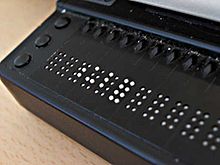Braille display
The Braille display , short line , or Braille display is a computer - output device for blind people, the character in Braille represents. They are usually controlled by screen readers that read out characters in selected areas of the screen and display them in computer glasses. This allows blind people to use large parts of the standard software and work independently on the computer.
The function of the Braille display is based on the piezoelectric effect of specially drawn crystals, which bend when an electrical voltage is applied and thus make a plunger protrude as a point from a surface, electronically controlled to create the characters in Braille . Users can feel the characters with their fingertips. Braille displays can display between 12 and 80 characters, depending on the model.
Control buttons are attached to the Braille display with which the displayed section of the screen can be moved.
Since more characters are required to work on the computer than can be represented with six dots, a fourth line is often added to the three dot lines in standard Braille, so that eight dots are available. In this way you get 256 combinations. The coding of the standard characters remains largely the same, however, the last line just remains empty.
Alternatively, screen readers can also offer voice output . Compared to reading aloud, Braille displays are more precise and reproduce word for word. This means that the spelling can also be checked directly without the voice output having to spell it out.
The purchase price for a line with only 40 characters is around € 6,000. If there is an indication, the costs for this are covered by the statutory health insurance in Germany . In Austria the costs are reimbursed by the Ministry of Social Affairs and the federal states. Due to the high prices despite the fact that the technology has remained almost unchanged since the 1980s, Braille displays are only sold in small numbers worldwide. There is no development in Germany towards inexpensive technology to reach people in countries without social security with a Braille display.
An association of several blind associations from all over the world has set itself the goal of breaking the price cartel of braille display providers in order to enable more blind people worldwide access to literature and modern technologies. When the project started in 2011, the aim was to bring a Braille display onto the market at a tenth of the price of conventional displays. 10 associations invested $ 1.25 million in the project. No association for the blind from Germany took part, which is why there will be no German-language documentation or sales. The product, the Orbit Reader 20, will sell for approximately $ 500. The hope is to change the market for the benefit of blind people worldwide. Few compromises have been made to a $ 6,000 device for the $ 500 goal. This includes a refresh rate of half a second and the elimination of so-called cursor routing buttons. Nevertheless, the modern device has a notebook function, internal memory, an operating system, WiFi and Bluetooth and it can be operated with all common screen readers on desktop computer systems and smartphones.
Braille surface displays
There are several approaches worldwide to improve the presentation of digital content for blind people. The single-line display of a few letters prevents multiple content from being displayed at the same time. For example navigation elements or structural information on content and orientation. In various designs, inexpensive electroactive polymers are used to represent the points instead of mechanical pens . So far only experimental research has been carried out in this direction, but no marketable product has yet been developed.
The HyperBraille project, based on the piezo element technology developed in the 1980s, was funded by the Federal Ministry of Economics and Technology (BMWi). With a project budget of approx. 10 million euros, the project was partially funded by the BMWi with approx. 5 million euros. The device weighs approx. 6 kg and has a unit price of approx. € 50,000.
Web links
- Product tests and detailed information on Braille displays in INCOBS
- Description of a braille display
- Yoseph Bar-Cohen: Electroactive polymers for refreshable Braille displays . SPIE. September 11, 2009. Retrieved September 21, 2014.
- Concept by Yanko Design , April 17, 2009
